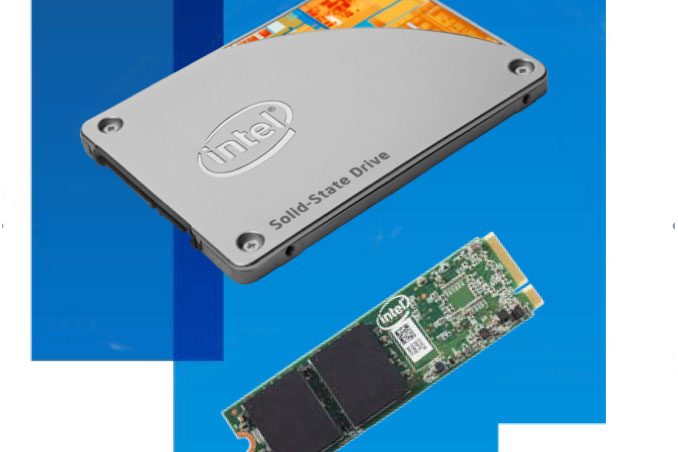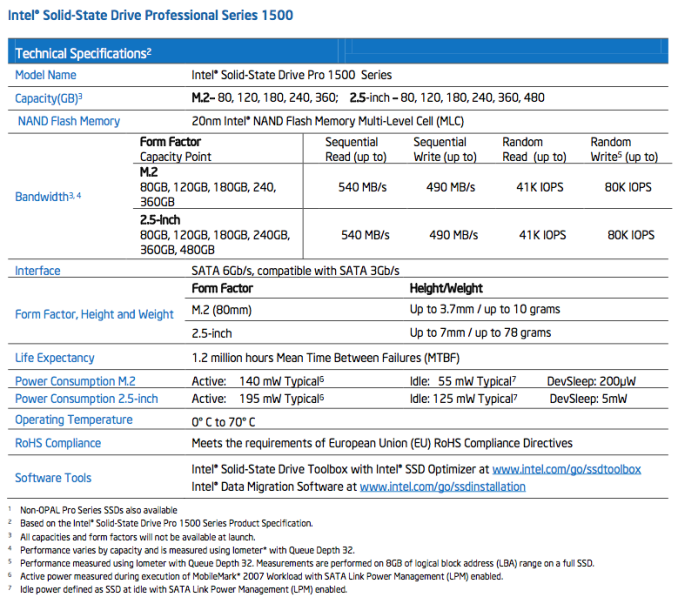Intel's SSD Pro 1500: SF-2281 with vPro Support, Aimed at OEMs/SIs
by Anand Lal Shimpi on September 9, 2013 11:00 AM EST- Posted in
- Storage
- SSDs
- Intel
- Intel SSD Pro
- Intel SSD Pro 1500

IDF 2013 is almost upon us, and Intel's NSG (NAND Solutions Group) is kicking off the pre-show with a new SSD announcement. The drive in question? Intel's SSD Pro 1500. This is the first non-datacenter drive to use Intel's somewhat new branding, following the format Intel SSD [segment modifier] [model number].
Despite the new name, the internals aren't all that new. At the heart of the Pro 1500 is a 6Gbps SATA SandForce SF-2281 controller, the same controller we've seen used in Intel's SSD 330, 335, 520 and 530. The SandForce controller continues to be paired up with Intel's own validated firmware, which should deliver a better experience than on other SandForce based drives. The SF-2281 controller is paired up with Intel's own 20nm 2bpc MLC NAND. The combination of the two will be available in 80GB, 120GB, 180GB, 240GB, 360GB and 480GB capacities.
Relatively known quantities aside, the Pro 1500 does bring a few new tricks to the table starting with form factor. Other than the 480GB model which is 2.5"/7mm SATA only, all of the other drives are available in both 2.5"/7mm and M.2 form factors. Of the M.2 models, the 80GB version is available in 2242 (22mm wide x 42mm long) and 2280 (22mm x 80mm) versions. The rest of the M.2 drives are all 2280. All of the M.2 flavors are SATA based (I have to make this clarification as the M.2 standard is somewhat ridiculous and can support either PCIe or SATA using the same connector).
The controller used appears to be a newer revision of the SF-2281 which support for lower power operation as well as DevSleep. The result is lower active, idle (HIPM+DIPM and DevSleep) than any of the older SF-2281 based drives. Note that new SSD 530 appears to have similar power characteristics to the Pro 1500.
| Intel SSD Spec Comparison | |||||||
| SSD Pro 1500 | SSD 530 | SSD 520 | SSD 335 | SSD 330 | |||
| Controller | LSI SandForce SF-2281 | ||||||
| NAND | Intel 20nm MLC | Intel 20nm MLC | Intel 25nm MLC | Intel 20nm MLC | Intel 25nm MLC | ||
| Capacities (GB) | 80/120/180/240/360/480 | 80/180/240/360 | 60/120/180/240/480 | 180/240 | 60/120/180/240 | ||
| Form Factors |
2.5" 7mm SATA M.2 2242 (80GB only) M.2 2280 (up to 360GB) |
2.5" 7mm SATA M.2 2280 (80/180/360) |
2.5" 7mm & 9.5mm SATA | 2.5" 9.5mm SATA | 2.5" 9.5mm SATA | ||
| Max Sequential Read | 540 MB/s | 540 MB/s | 550 MB/s | 500 MB/s | 500 MB/s | ||
| Max Sequential Write | 490 MB/s | 490 MB/s | 520 MB/s | 450 MB/s | 450 MB/s | ||
| Max Random Read | 41K IOPS | 41K IOPS | 50K IOPS | 42K IOPS | 42K IOPS | ||
| Max Random Write | 80K IOPS | 80K IOPS | 80K IOPS | 52K IOPS | 52K IOPS | ||
| AES-256 | Y | Y | N | N | N | ||
| TCG Opal | Y | N | N | N | N | ||
| Intel vPro/SCS | Y | N | N | N | N | ||
| Power (Active) |
140 mW (M.2) 195 mW (2.5") |
140 mW (M.2) 195 mW (2.5") |
850 mW | 350 mW | 350 mW | ||
| Power (Idle) |
55 mW (M.2) 125 mW (2.5") |
55 mW (M.2) 125 mW (2.5") |
600 mW | 275 mW | 275 mW | ||
| Power (DevSleep) |
200 µW (M.2) 5 mW (2.5") |
200 µW (M.2) 5 mW (2.5") |
- | - | - | ||
| Warranty | 5 years | 5 years | 5 years | 3 years | 3 years | ||
The Intel SSD Pro 1500 features AES-256 encryption support as well as TCG Opal compliance. There's no mention of IEEE-1667 so I don't believe the 1500 is eDrive compatible. The Pro 1500 also adds vPro and Intel Setup & Configuration Service 9.0 support, allowing for remote management and diagnostics of the drive even if the platform is turned off. Ultimately it's the TCG Opal and Intel vPro/SCS support that separates the Pro from conventional Intel SSDs.
The Pro 1500 will be primarily sold through OEMs and SIs although there will be limited quantities available in the channel. The 1500 carries a 5 year warranty.











19 Comments
View All Comments
nutgirdle - Monday, September 9, 2013 - link
What is involved to move all of these NGFF cards over to using PCIe? Drivers? New silicon? $$? It seems that with the ridiculous performance of the SSD's in the new Macbook Air's, everyone should be moving that way as fast as possible.extide - Monday, September 9, 2013 - link
You just need a native NAND Controller. OR You could put a PCIe to SATA bridge, and 1-2 SATA based NAND controllers in raid, but that would obviously be less desirable. I am not sure how the MBA SSD works, since it is proprietary and exactly 2 lanes, it could be using a 2 lane PCIe SATA RAID controller and two sata nand controllers (sandforce, toshiba, whatever)NOTE: That is PURELY a guess about the MBA and I may be wrong. I, myself, have not read any articles that dig into that particular SSD in depth, however there may well indeed be some out there.
extide - Monday, September 9, 2013 - link
EDIT: You just need a native *PCIe* NAND Controller.boogerlad - Monday, September 9, 2013 - link
The Macbook Air uses a samsung pci-e controller.Teardroop - Monday, September 9, 2013 - link
yep, wait for sandisk u110 or something similarHrel - Monday, September 9, 2013 - link
Patiently waiting for the 380GB drives to be priced at $250 MSRP. The performance of these drives is truly game changing but unless a person can afford the 250GB drive I have no choice but to recommend a hybrid solution or just straight mechanical disk. If you need storage and your budget dictates it's either/or then there's really no choice.Sadly until prices come down significantly more these will remain premium parts.
WhitneyLand - Monday, September 9, 2013 - link
Dude come on :). It used be everyone was waiting for $1/GB. Now we are waiting for something else?I think there is just a continual list of these transition points where SSDs keep becoming newly relevant to people in their particular scenarios.
Maybe the last of these is, cheaper than 4TB magnetic storage so all new home NAS builds will be SSD only. :)
bdmarsh - Monday, September 9, 2013 - link
That would be interesting - with even the "low-end" SSD performance so high compared to traditional drives, to gear a release to NAS type usage. Low price/GB and long term usage as the priorities.pixelstuff - Tuesday, September 10, 2013 - link
People can afford however much they want to afford. It's just a matter of how long they want to wait or how many other "things" they want to hold off on.For example in my opinion an 256GB SSD is totally worth the money and 256GB is the right size for Windows+most apps. But I don't think having 2TB of those drives is necessary to get that kind of performance on every single file I access.
I've tried to convince some friends (who always complain about computers and how they are a pain to work with) that their next laptop should have an SSD with a nice screen and good fit-n-finish. Something like a $1,500 Samsung ATIV or Series 9.
Instead they buy some $500 thing with a traditional low res screen, bulky plastic body, and a large but slow HDD. However, it's not for lack of money, because a couple months later they turned around and bought a new (to them) motor cycle, purely for fun, for over twice the price of a high end laptop for.
speculatrix - Monday, September 30, 2013 - link
+1A relative recently bought a BMW convertible near top of the range and was happy to pay extra for nicer wheels, upgraded radio/cd etc, all of these extras cost far more than a decent PC.
Yet when replacing his PC he wanted to skimp on memory and bought a PC with just 2GB RAM and a middle to low spec CPU.
He probably uses both the car and the PC for similar amounts of time each day and whilst he doesn't complain he does mumble about wishing it was a bit faster.